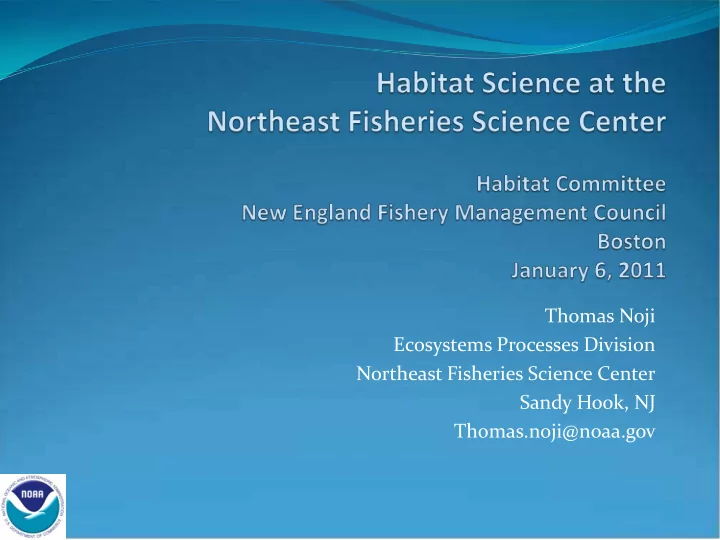

Thomas Noji Ecosystems Processes Division Northeast Fisheries Science Center Sandy Hook, NJ Thomas.noji@noaa.gov
Overview Habitat Assessment Improvement Plan Content Key Findings Key Recommendations NEFSC Habitat Research Activities Climate Change Coastal and Marine Spatial Planning Habitat-dependent processes and fish life histories
NOAA Fisheries
Why Habitat? 4
Goals of the HAIP Magnuson-Stevens Act mandates Improve identification and impact assessments of EFH Reduce habitat-related uncertainty in stock assessments Contribute to assessments of ecosystem services Climate change Ecosystem-based management, integrated ecosystem assessments, and coastal and marine spatial planning
What is a Habitat Assessment? 6
Three Tiers of Habitat Assessments Tier 1: Comprehensive evaluation and synthesis of existing habitat information by life stage Tier 2: New or expanded data collection and research initiatives result in a higher level of habitat assessments Tier 3: Provide quantitative estimates of fish productivity by habitat and ecosystem considerations for incorporation into stock assessments
Current State of Habitat Assessments Data collection and data management programs are inadequate Current levels of available infrastructure and advanced technologies need to be increased Disconnect between habitat scientists and resource managers on priorities and needs 8
Staffing Issues Only ~5% of NOAA Fisheries staff are currently working on habitat science activities Many habitat-related staff are contractors or students supported with transient, non-NOAA funds Habitat staff time is fully committed (in many cases overcommitted) Additional staff will be necessary to achieve improvements to habitat assessments
Key Recommendations of the HAIP Develop criteria to prioritize stocks and geographic locations that would benefit from habitat assessments Identify and prioritize data inadequacies for stocks and their respective habitats Habitat and stock assessment scientists should work together to initiate demonstration projects that incorporate habitat data into stock assessment models Convene regional and national workshops to develop strategies to integrate habitat science and assessments, stock assessments, and integrated ecosystem assessments 10
Outcomes to Date Development/publication of HAIP has increased awareness of habitat science within NOAA Fisheries Basis for new budget initiatives and the new Habitat Monitoring and Assessment capability Three joint habitat/stock assessment pilot projects have been funded and are underway New call for proposals on the streets now 1 st National Habitat Assessment Workshop held in May 2010
Download a copy of the HAIP: http://www.st.nmfs.noaa.gov/st4/HabitatScience.html Contact your HAIP representative: Mary Yoklavich, SWFSC Bob McConnaughey, AFSC (Chair) Tom Minello, SEFSC Michael Parke, PIFSC Tom Noji, NEFSC Frank Parrish, PIFSC Kristan Blackhart, OST Correigh Greene, NWFSC Steve Brown, OST Waldo Wakefield, NWFSC Susan-Marie Stedman, OHC
Ecosystems Processes Division Priorities Mission : Understand the effects of environmental variability and human disturbances on fish and shellfish productivity relative to habitat • Effects of climate change, ocean acidification and human activities (e.g. renewable energy production) on coastal habitats and fisheries • Coastal and marine spatial planning including mapping and assessment of fish habitat condition • Habitat-dependent processes and fish life histories in support of resource management modeling
Climatic Effects on Biological Productivity and Sustainable Fisheries in the Northeast U.S. Continental Shelf Large Marine Ecosystem •Overall productivity •Individual fish and shellfish stocks •Predicted on timescales meaningful to fisheries managers •Most important factors required for modeling •The environment and biota to be monitored •Are we prepared to respond?
Ocean acidification- species response - finfish Protocols and Design Species – diverse ecologies Response variables EGG / SPAWNING PRIMARY SPECIE S LARVAL Sperm VALUE SEASON HABITAT motility black sea shelf / water Embryo summer economic bass column development shortnose spring- estuaries to fresh endangered sturgeon summer / benthic Larval growth Atlantic estuaries to fresh species of and condition summer / benthic concern sturgeon Metamorphosis summer autumn- shelf / water economic and settlement winter column flounder winter estuaries / winter-spring benthic / water economic flounder Otolith growth column and symmetry Atlantic estuaries to fresh winter / benthic / water trophic tomcod column Atlantic estuaries / summer trophic benthic killifish
Coastal and Marine Spatial Planning haddock sea scallop hydrozoans GIS Mapping Group Habitat Atlas sea scallops & pebbles on sea scallop deck Area viewed, 20 x 30 in (51 x 76 cm)
Broad-scale Habitat NEFSC – CCOM Partnership for collection and processing of acoustic oceanographic data • To improve our ability to handle the flow of acoustic data • To develop a program to routinely process these acoustic data collected by the NEFSC; • To develop solutions to particular (non-routine) data- interpretation challenges.
• Winter flounder habitat • National Fish Habitat Action Plan (NFHAP) • Deep Water Coral Workshop • Habitat modeling • Pelagic Depth Mean Grain Size ( O ) (m at MLW) • Benthic -1.5 - -0.5 0.2 - 1.4 m 1.4 - 2.7 m -0.5 - 0.3 2.7 - 3.7 m 0.3 - 1.3 3.7 - 5.0 m 1.3 - 2.2 5.2 - 6.5 m 2.2 - 3.1 6.5 - 7.7 m 7.7 - 9.0 m 3.1 - 4.1 9.0 - 10.4 m 10.4 - 11.5 m Sediment Organics Sediment Shell (% dry wt) (% dry wt) 0 - 2 0 - 2 2 - 4 2 - 4 4 - 6 4 - 6 6 - 8 6 - 8 8 - 10 8 - 10 10 - 12 10 - 12 12 - 14
Next Steps Habitat Support to the Council How? EFH revisions Omnibus EFH Plan Coordinate regionally Habitat workshops
Recommend
More recommend